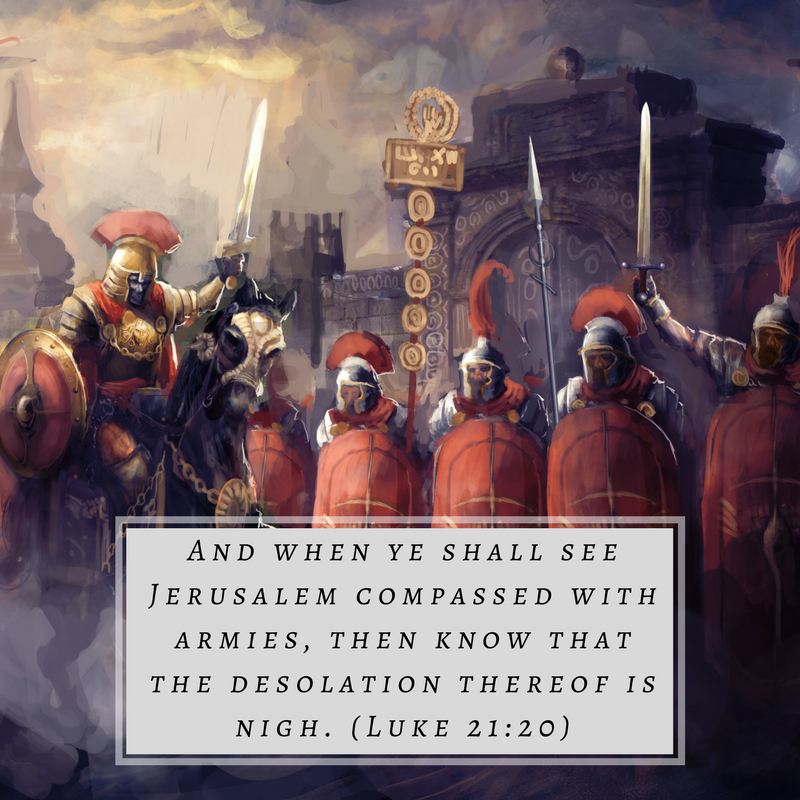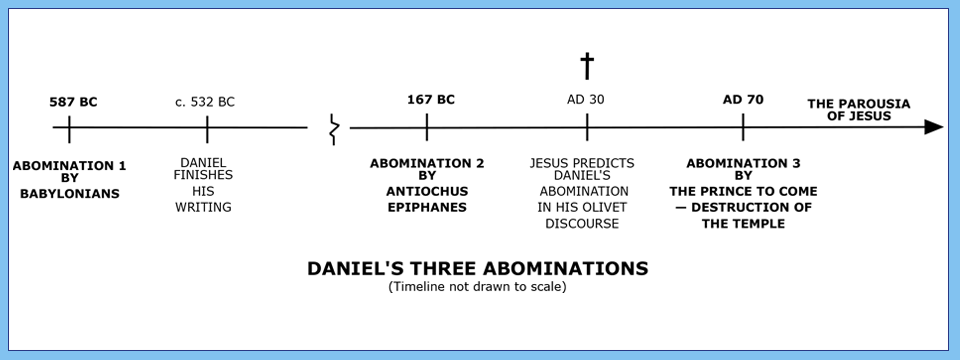
This post examines one of the most interesting signs Jesus gave for the destruction of the Temple—”the abomination of desolation” (Matthew 24:15).
If you have not read our previous posts, we recommend you begin with our “Start Reading Here” page. We are developing an improved (we trust) model for interpreting biblical prophecy. Your quick review of our progress to this point will set the stage for the following discussion about the abomination of desolation.
We again encourage you to imitate the noble Berean Christians and search the Scriptures to confirm the truth of statements made here (Acts 17:11). Should you have a question or comment, please leave a note in the comment field below this post.
Abominations in Daniel
Jesus told his disciples they would “see the abomination of desolation, spoken of by Daniel the prophet, stand in the holy place” (Matthew 24:15). This would serve as one of the later signs associated with the destruction of the Temple (cp. Matthew 24:1–3).
Since Jesus drew this sign from Daniel, we must understand—at least at a high level—what that prophet said about the abomination of which Jesus spoke.
Daniel finished his book around 532 BC.1 In it, he described three Temple desolations. The following list is in order of their historical fulfillment: the desolation by the Babylonian armies (Daniel 9:2, 17–18); the “little horn” desolation (Daniel 8:9–27; Daniel 11:31) and the desolation of “the prince that shall come” (Daniel 9:26–27; Daniel 12:11).2
Anticipating the discussion below, we can depict these prophecies in the following diagram:

1st Desolation—by the Babylonian Armies
Chronologically, the first desolation Daniel mentioned had already occurred. The prophet Jeremiah, writing around “the years 627–587 B.C. (or perhaps a little later),”3 had foretold this event and its subsequent reversal. He informed the Jews God would send the king of Babylon to make “perpetual desolations” against Israel (Jeremiah 25:8–10).
Jeremiah had also predicted the return of Israel to the land and the rebuilding of the Temple seventy years after this desolation (Jeremiah 25:11–12; 29:10). The king of Persia allowed the Jews to return to their land after seventy years, just as Jeremiah had promised. They then built the second Temple4 (cf. Ezra 1:1f). This restoration reversed the effects of the first desolation: the Temple sacrifices resumed.
2nd Desolation—by the Little Horn (i.e., Antiochus)
Daniel predicted a second “transgression of desolation” (Daniel 8:8–27).5 Antiochus Epiphanes6 fulfilled this prophecy in the month Tishri, 167 BC.
Daniel’s prophecy also contained a promise of restoration—“then shall the sanctuary be cleansed” (Daniel 8:14). Judas Maccabaeus fulfilled this prophecy in “the rededication of the temple on 25 Chislev (or 14 December) 164 B.C.”7
3rd Desolation—by “the prince that shall come”
God had thus fulfilled two desolation prophecies—one each by Jeremiah and Daniel— before Jesus gave the Olivet Discourse. So, Jesus was not referring to either of these desolation prophecies as a sign of the destruction of the Temple.
The disciples knew how the Jews rebuilt the Temple after their Babylonian captivity. They also knew Judas Maccabaeus had restored and cleansed the Temple after its second desolation. They kept the “feast of the dedication” (John 10:22) to commemorate this event. We conclude, therefore, that they knew Jesus spoke of Daniel’s third desolation—the one caused by “the prince that shall come.”
Daniel prophesied twice about this event—in Daniel 9:26–27 and in Daniel 12:11. Over five centuries later, Daniel’s prophecy remained unfulfilled. Jesus now told his disciples the fulfillment of Daniel’s third and final desolation prophecy would come with the destruction of the Temple.
Abominations and Our Model
Two details of Daniel’s third Temple desolation impact our developing prophetic model. First, this desolation was to follow the death of the Messiah for the sins of his people. These two events were connected. Daniel said the Messiah would “be cut off, but not for himself” (Daniel 9:26), then “the people of the prince that shall come shall destroy the city and the sanctuary . . . and . . . he shall cause the sacrifice and the oblation to cease, and for the overspreading of abominations he shall make it desolate” (Daniel 9:26–27).
This is also the sequence of events in Jesus’ signs leading to the destruction of the Temple. He had already told the disciples he would suffer death in Jerusalem, but rise again the third day (e.g., Matthew 16:21). After his death, the disciples would witness the signs we are now discussing: first, the general signs he had listed, then the sign of Daniel’s third desolation of the Temple would end “the sacrifice and the oblation.”
Second, this prophecy of desolation—both as Daniel wrote it and as Jesus referred to it—included no promise of restored sacrifices and Temple services. Instead, this prophecy emphasized the finality of the third desolation. Daniel said the prince would destroy Jerusalem; he would “cause the sacrifice and the oblation to cease, and for the overspreading of abominations he shall make it desolate, even until the consummation, and that determined shall be poured upon the desolate” (Daniel 9:27).
This desolation would occur at “the time of the end” (Daniel 12:9).8 Again, Jesus reflected this same perspective when he associated the desolation of the Temple with “the close of the age” (Matthew 24:3, RSV). God designed the Temple for the then-present (Mosaic) age; it would be out of place in the parousia of the Son of man (or Messianic age) that would follow this final desolation. There is no promise in Daniel (or any other prophet) that God would reinstate the daily sacrifices inherent in the Mosaic system after the desolation of which Jesus (and Daniel) spoke. Once the end of that (Mosaic) age came, the physical Temple in Jerusalem would no longer play a part in God’s redemptive work.
With this clear note of finality in the writings of Daniel, we can imagine the incredible effect Jesus’ prophecy about the demise of the Temple had on the disciples. Jesus had said they, not some future generation, would see this final desolation. This event would change their world forever. They must have wondered how this abomination of desolation would occur.9
The New Testament Explanation
Jesus did not leave the disciples uninformed about the agents of this desolation. Luke’s account of the Olivet Discourse includes certain details not recorded by Matthew or Mark. There, Jesus told the disciples: “And when ye shall see Jerusalem compassed with armies, then know that the desolation thereof is nigh” (Luke 21:20). Invading armies would accomplish the final desolation of the Temple.
From our historical vantage point, we know these were Roman armies. Rome sent her armies to Judea to squelch rebellion by Jewish zealots. The massive invasion from the North began in AD 66. The Roman troops marched through the land, using “scorched earth” tactics, burning town after town and many square miles of countryside. They surrounded Jerusalem and destroyed the Temple in AD 70, about forty-two months after the invasion began.10
Using Luke’s account of the Olivet Discourse and reliable historical documents, Matthew Poole identified the abomination of desolation with
the Roman armies, which being made up of idolatrous soldiers, and having with them many abominable images are therefore called the abomination . . . because they were to make Jerusalem desolate. . . . When, saith our Lord, you shall see the abominable armies stand in the holy place, that is, upon the holy ground, (as all Judea was), whoso readeth those prophecies of the prophet Daniel, let him understand, that as through the righteous judgment of God he once suffered the holy place to be polluted by the abominable armies of Antiochus, which he foretold, so he will again suffer the holy place to be polluted by the abominable armies of the Romans, who shall make the holy place desolate, which was prophesied by the prophet Daniel as well as the former. Therefore, saith our Saviour, when you see the Roman armies pitch their tents before Jerusalem, be you then assured God will give Jerusalem into their hands, and then all that I have foretold shall come to pass.11
At least some of the disciples lived to see the Roman invasion and the abomination of desolation of which Jesus spoke. They no doubt recalled this sign their Lord had given.
Conclusion
Jesus’ prophecy of the abomination of desolation fits well in our developing prophetic model. It directly affected the disciples. Jesus told them how to escape the turmoil associated with this sign. They must “flee to the mountains” (Luke 21:21). Just before the Temple fell, the Christians did just as their Lord had instructed and survived the tribulation.12
What does this mean for us? It means the abomination of desolation is a thing of the past. God has moved his drama of redemption beyond the Temple and its sacrifices. They were temporary and pointed to Jesus Christ, the one true sacrifice God has now provided (Hebrews 10:1–18). We look forward, not to another abomination in an earthly Temple, but to the glorious accomplishments of the Messianic kingdom now established—the conversion of the nations, the defeat of all Christ’s enemies, etc. (See He Must Reign and Hooray for Big Government.)
The abomination of desolation served as one of Jesus’ later signs of the final destruction of the earthly Temple. Jesus gave two other later signs. Lord willing, we will consider the “great tribulation” in our next post.
Footnotes
- Gleason L. Archer, Jr., “Daniel,” in The Expositors Bible Commentary: Daniel and the Minor Prophets, ed. Frank E. Gaebelein (Grand Rapids: Zondervan, 1986), 6.
- For support for this division of the abominations of desolation, see James Farquharson, A New Illustration of the Latter Part of Daniel’s Last Vision and Prophecy (London: Smith, Elder, and Co., 1838). This rare work is available in digital format from American Vision.
- Peter C. Craigie, Page H. Kelley, and Joel F. Drinkard Jr., Jeremiah 1-25, Vol. 26, Word Biblical Commentary (Dallas: Thomas Nelson, 1991), xlv.
- The one standing when Jesus spoke the Olivet Discourse. Herod’s extensive enhancements to this structure were almost completed by that time.
- Daniel 11:31 also refers to this pollution of the sanctuary and “the abomination that maketh desolate.”
- The identification of the little horn in Daniel’s prophecy with Antiochus is common among scholars. See, for example, John E. Goldingay, Daniel (Dallas: Word, 2002). The small horn growing from the Seleucid line was Antiochus IV.
- For both desolation and restoration see Archer, “Daniel,” 103. See 1 Macc. 1:54 for the desolation (Archer provides pertinent details) and 1 Macc. 4:52–53 for the cleansing. See also 2 Macc. 5:20; 10:1–8.
- For a defense of the assertion that Jesus referred to the desolation of Dan. 12, see Farquharson, Daniel’s Last Prophecy.
- These observations may challenge the beliefs of some of Jesus’ disciples today, too. If this is true of you, please search the Scriptures for clear evidence for a third Temple and a future abomination of desolation. I will be happy to discuss the results of your research if you will leave a note in the comment field below.
- Details of these wars were recorded by Flavius Josephus, a Jew who witnessed these events. See Flavius Josephus, The Wars of the Jews, trans. William Whiston (Grand Rapids: Baker, 1974).
- Matthew Poole, A Commentary on the Holy Bible (Carlisle, PA: The Banner of Truth Trust, 1962), 3:114.
- See Whiston’s note in Flavius Josephus, The Antiquities of the Jews, trans. William Whiston (Grand Rapids: Baker, 1974), 2:19:6.
